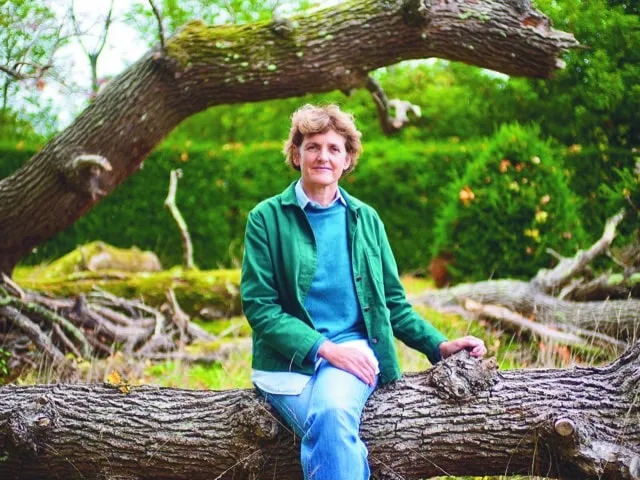Isabella Tree’s book about the rewilding of Knepp Estate became an inspirational totem for the eco-conscious. Now she’s back with a new practical guide – Amanda Constance meets her

It’s not often one gets to belly laugh about escaped beavers with an interviewee. But then I am talking to Isabella Tree, the oft-monikered ‘Queen of Rewilding’ and custodian of Knepp Estate in Sussex, now a globally renowned rewilding project. She is recounting the story of when she and her husband, Charlie Burrell, first attempted to introduce a pair of beavers to the estate a few years ago. “We were given a licence that meant we didn’t have to pen them in. We just had to re-enforce streams – so we did all that, spent tens of thousands of pounds on steel culverts and God knows what. The consensus from the ecologists was that should be enough wetland and willow to keep the beavers happy on Knepp for 10 years before they looked further afield. But within two weeks of being introduced both beavers had disappeared – one of them had crossed 17 weirs and was found at Shoreham-by-Sea.” Cue much mirth from Tree, who says the escapees were donated to the National Trust who had an adequate pen. And Knepp is now home to a bonded pair from Scotland – “who actually like each other’ – and have “created two to three acres of water out of what was a tiny dribbly stream”. The female is pregnant and kits are expected this month.
This is Isabella Tree’s world. While many wake to the daily slog of a grimy urban commute, she rises at Knepp to a deafening dawn chorus, the clattering bills of the white storks that nest on the castle turrets, and the sight of Longhorn Cattle, direct descendants of the ancient Auroch, wandering the grounds. It is otherworldly and utterly magical.
Yet it wasn’t always like this. Twenty years ago, the 3,500-acre Knepp Estate that Burrell – or Sir Charles Burrell, 10th Baronet to use his full name – had inherited aged 21 was an exhausted and unprofitable farm and the couple were up to their ears in debt. Their radical choice to try something new, to depart from chemically aided conventional farming practices and let nature take over was documented in Tree’s 2018 book Wilding: The Return of Nature to a British Farm.
That book has since become a keystone species within the growing pantheon of nature writing and has accrued Tree and Knepp a devoted army of fans inspired by its story. “The whole rewilding project here at Knepp has taken us completely by surprise,” Tree says. “First of all, in how successful it’s been in terms of bringing back wildlife – from our completely mucked up depleted farm underneath the Gatwick stacking system we turned it into something completely astonishing.And the public response has been “amazing”, she says.
Knepp is now a highly successful business. Not only is it a biodiversity hotspot – more than 20 universities are currently conducting studies on the estate – it runs wildlife safaris, hosts a camping and glamping business, has an online shop selling its wild range meat and a new restaurant is set to open this year. The estate now makes more money than it ever did as a conventional farm.
It’s a lot to be getting on with, isn’t it? “Life has become incredibly busy because of the interest,” admits Tree, “but it’s so positive that that is a kind of boost in itself.”
The success of Wilding meant “we had a tsunami of enquiries from people” says Tree. “From big landowners to smaller farmers to people saying, ‘I’ve got a garden, an allotment, an orchard….’ And everyone asking the same question, ‘What Can I Do To Help’?” she says.
Unable to answer everyone individually, Tree and Burrell’s solution was to put pen to paper again. The Book of Wilding, published last month, is “a practical how-to guide more than a manifesto,” says Tree. It’s a hugely detailed doorstop of a book that is “for everyone”. Ambitious in scope, it starts with the large landscape picture so that if you are applying it to a garden, allotment or even window box you have that “large scale understanding”, Tree explains.
“For us, rewilding is a mindset, an approach,” she says. “Obviously, the smaller space you have, the more you need to manage and intervene in order to get exciting things happening to mimic the natural processes that go on in a landscape.”
Natural processes are something Tree talks about a lot. “I think there is a misconception about rewilding that it is just about letting things go – about abandoning your garden, but it’s not.” As Tree demonstrated in Wilding, successful rewilding is about re-establishing the natural way of things and that can require a bit of human intervention at the start.
What you need is “disturbance” of the land, Tree explains. At Knepp this is done by cattle, pigs and deer. Large herbivores aren’t quite as practical in London, so Tree suggests that gardeners mimic the work of animals such as wild boar. “You can become the keystone species as a human. That’s the difference, I think, between a nature friendly garden and a rewilding approach to your garden. You are just thinking differently.”

Tree often suggests that we mimic animals. While extolling the virtues of putting in a pond to create a nature-friendly garden she immediately adds, “and act like a beaver”. Beavers, it seems would include some dead wood – good for water invertebrates – and then “you might behave like a water buffalo” and trample the edges of the pond, “creating dips and hollows where frogs, toads and newts can breed.”
Tree believes there is fantastic potential for rewilding in cities. “People living in cities have a very open mind. They haven’t grown up in a rural environment where hedgerows are clipped to within an inch of their life.” Her chapter on urban rewilding delves into “how we need areas to connect if we are really going to have wildlife back in our cities”. She cites a friend in Bristol who has rewilded his back garden so successfully that it is now home to 25 grass snakes. He has also approached neighbours who are working together to remove fencing, grow wildflower lawns and create ponds. “So you’ve suddenly got a mosaic of habitats, all connected, which becomes very rich for wildlife which is very exciting.”
Connectivity is Tree’s new ambition. The next step for Knepp is the Weald to Waves initiative – creating a corridor of connected land from Low Weald of Sussex to the south coast. But before she rewilds much of southern England, she needs to pay attention to her own garden. “For 15 years we’ve been thinking about the wider landscape, yet we were still mowing our own lawn here with a zero-tolerance approach to dandelions,” she laughs. “My God, there’s our blind spot. We’re sitting right in the middle of our blind spot.”








